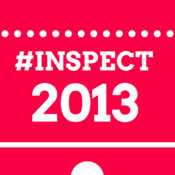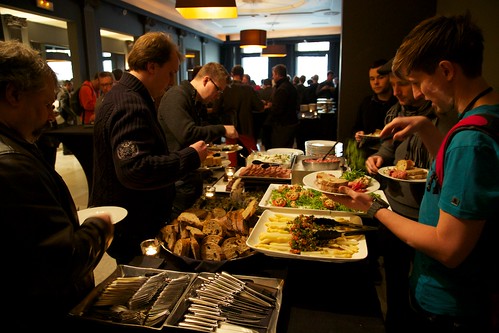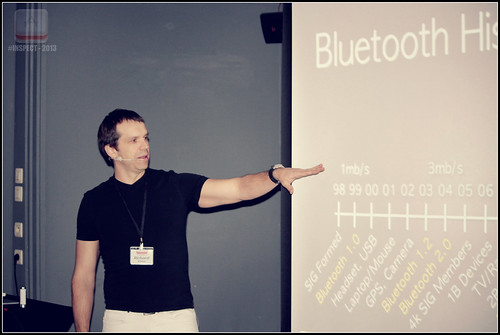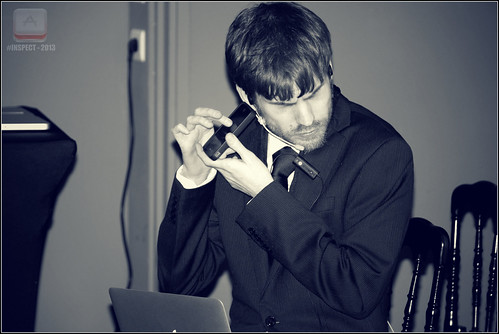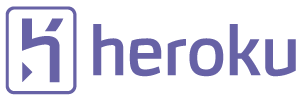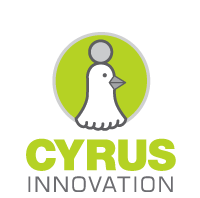-
21 Apr
RubyMotion #inspect 2013 Wrap-Up
Just a few weeks ago the first RubyMotion conference was happening in our home town of Brussels, Belgium! And guess what, it was pretty awesome!
It was the first conference we ever organized. We would like to share our experience in this post as well as cover what happened!
The Venue
We wanted the first conference to be friendly, diverse and exclusive. We initially fixed the maximum number of attendees to 100 because we knew that over this limit it would have been difficult for everyone to meet up and chat. We eventually raised the limit to 130. Despite the fact that the majority of RubyMotion users are located in the United States, we also knew that we wanted the conference to happen in Belgium, for practical reasons.
It took us quite a bit of time to find the conference venue. We visited a few venues but they didn’t really match what we had in mind. We wanted the venue to be special, unusual, and at the same time professional and prestigious. We also wanted the venue to be in the historical center of Brussels, because the area is full of hotels, restaurants, bars, and tourist attractions. Organizing the conference in a hotel near the airport was therefore out of the question.
The Grand Place is Brussels’ main square and also the center of its historical center. We started looking around for potential venues and we eventually figured out it was possible to rent a house on the Grand Place itself! We quickly jumped on the opportunity.
We got 130 visitors from every continent. A lot of different accents were heard, making the event very diverse. Most of the attendees were visiting Belgium for the first time, so they got to taste our awesome beers and chocolates!
The Schedule
The conference featured a single track over 2 days. We pre-selected 10 speakers for the announcement and opened a call-for-papers. We originally wanted 18 presentations.
Pre-selecting as many speakers was probably a mistake because we received close to 80 talk proposals. We didn’t expect to receive as many talk proposals and it was very tough to decide on the remaining selection. We had to reject a lot of very interesting talks.
We eventually decided to go with 20 presentations, which means we had to fit 10 talks each day, and still leave enough room for breaks and lunch. We took over the challenge and eventually managed to finish the conference on time!
We decided not to print the schedule on paper and preferred to have an iOS app instead. We teamed with the awesome folks at Epic, who already made the conference website, to create an iPhone app for the conference. The app was obviously written in RubyMotion, using the Teacup and Sugarcube libraries. You can find the full source code on GitHub.
The Food
Offering delicious food was extremely important to us. We did not want to give away dry sandwiches that you can find in most conferences.
We welcomed visitors with fresh pastries (cooked onsite), coffee, tea and juices. Each attendee also received chocolates from Benoit Nihant's Haute Couture selection. Benoit is one of the remaining true chocolatiers of Belgium.
For lunch, our attendees had access to a full Belgian buffet which included cured meats, steak tartare, duck, various salads, fresh vegetables, salted waffles and more. A huge assortiment of homemade deserts was also available, including chocolate mousse, fruit tarts, tiramisu, and more. And we of course served beer!
Most attendees told us they had the best conference food experience ever.
The Shirt
We designed the conference shirts by ourselves. We didn’t want to go with a traditional “conference name + date” shirt, so we iterated quite a bit on the design.
We finally ended up choosing to represent a coat of arms. The logo we went with features two wyverns (an homage to the LLVM project) supporting the existing RubyMotion logo on a white shield, crowned with a sparkling ruby.
The motto is written on a white ruban and reads "#inspect RubyMotion 2013".
The Presentations, 1st Day
A Brave New World: Learning iOS for the Ruby Refugee, by Nick Quaranto (slides available). Nick covered his experience using RubyMotion to write a couple sample projects (which eventually turned into the official Basecamp iPhone app) and talked about the motion-settings-bundle and motion-autolayout gems he extracted in the process. We later recorded an interview with Nick that you can also check out.
Behaviour Driven Motion using Calabash, by Karl Krukow (slides available). Karl introduced the Calabash framework and how you can write acceptance tests for RubyMotion apps with it, using the motion-calabash gem. (Note: A few days later it was announced that LessPainful, Karl’s company, was acquired by Xamarin.)
Controlling the Real World with RubyMotion, by Rich Kilmer (slides available). Rich talked about the history of bluetooth, starting from the first specification up to the bluetooth4 standard, and described the APIs that you can use to interface from RubyMotion. And before you ask, yes, Rich was wearing white pants.
Elevate your Intent, by Matt Green (slides available). Matt talked about the complexity that can rise when designing iOS apps and offered a solution through his elevate gem that we recommend checking out.
Accessibility and RubyMotion, by Austin Seraphin (slides available). Austin, a blind developer, talked about accessibility and how RubyMotion makes it easier for blind people to develop apps. Undoubtedly one of the most acclaimed talks of the conference. Austin also covered his trip to the conference in 3 blog posts that we highly recommend: An Unexpected Journey, #inspect 2013, and The Journey Home.
CoreData For The Curious Rubyist, by Jonathan Penn (slides available). Jonathan introduced CoreData, Apple’s framework for data persistence. He covered what CoreData is, when to use it, and the builtin framework classes you will have to deal with when integrating it in your app. Demo code available.
The Life and Times of an Object, by Joshua Ballanco. Josh started with a simple app that was crashing and investigated the crash using low-level tools such as gdb and malloc-history. Eventually, it turned out that the bug was in the RubyMotion runtime!
Concurrency in RubyMotion: Use the Multicore Luke!, by Mateus Armando (slides available). Mateus talked about how it is necessary to use concurrency and the various approaches to it, such as GCD and NSOperationQueue.
Get More From RubyMotion with RubyMine, by Dennis Ushakov. Dennis didn’t have any slides, he simply started developing a RubyMotion app straight within RubyMine and demo’ed the excellent RubyMotion integration we (HipByte and JetBrains) have been working on together, featuring smart auto-completion, debugging on simulator and device, refactoring, documentation viewer, and more.
Crafting iOS Dev Tools in Redcar, by Delisa Mason (slides available). Delisa talked about Redcar, an open-source editor written in Ruby, and introduced its very extensible plugin infrastructure. She eventually showed how she managed to integrate RubyMotion in Redcar.
The Presentations, 2nd Day
NSRevolution: How Ruby hackers built the new Objective-C Open Source community, by Mattt Thompson (slides available). Mattt talked about the influence of the Ruby community on the younger iOS community.
More Than You Need to Know About CocoaPods, by Eloy Duran (slides available + video 1 and video 2). Our hero Eloy talked about CocoaPods, the missing package manager for Objective-C libraries, and also featured a sneak-peak at their sister project, CocoaDocs.
Wrapping iOS in RubyMotion, by Clay Allsopp (slides available). Clay covered various techniques you can use to create elegant and nice Ruby wrappers on top of iOS API patterns, such as callbacks, delegates and enumerations.
Goodbye IB, Hello Teacup, by Colin Gray (slides available + video). Colin started talking about Teacup, a library to style user interfaces, and eventually announced motion-xray, a powerful iOS inspector running inside RubyMotion apps that can be opened using a device gesture.
Using BubbleWrap to Quickly Build RubyMotion Apps, by Marin Usalj (slides available). Marin gave a nice overview of the Bubblewrap project, which aims at becoming the ActiveSupport of RubyMotion.
Mixing CoffeeScript in RubyMotion apps, by Michael Erasmus (slides available). Michael talked about his experience building a cross-platform mobile app where CoffeeScript was used to build the common logic.
Building Interactive Data Visualization Charts, by Amit Kumar (slides available). Amit talked about the various libraries one can use to integrate interactive charts in an iOS app, and eventually announced the motion-plot gem, a nice RubyMotion wrapper sitting on top of the CorePlot framework.
Cocos2D, an Easier Way, by Juan Karam (slides available). Juan talked about his gaming experience, basic game programming concepts, and eventually announced Joybox, a RubyMotion gaming library integrating the popular Cocos2D and Box2D frameworks. He even wrote a simple game during his talk!
Let’s Move with CoreMotion, by Akshat Paul and Abhishek Nalwaya (slides available). The inseparable friends gave a speedy talk about CoreMotion, Apple’s framework for motion sensors integration. They talked about the core builtin classes and how you can use them from RubyMotion.
RubyMotion: Past, Present and Future, by Laurent Sansonetti. Laurent gave the final conference presentation. He talked about what made him create RubyMotion, the current state of the project, and what the future holds.
The Party
We concluded this wonderful conference with an awesome party!
Our friends at GitHub graciously sponsored the party. We booked the entire Hoppy Loft room of the Delirium Cafe, one of Brussels’ legendary pubs, which features thousands of different beers.
Conference attendees were able to taste quite a lot of delicious Belgian beers. We ended the party at around 4AM!
The Sponsors
RubyMotion #inspect 2013 would not have been possible without the support of our great sponsors.
Our lead gold sponsor. Heroku is the first and best multi-language cloud application platform, or platform-as-a-service. Heroku allows developers to deploy, scale, and manage their apps without needing to think about servers or systems administration. Over one million applications have been deployed to Heroku.
One of our silver sponsors. JetBrains is a world leader in smart development tools that help software developers simplify their challenging tasks and automate the routine ones. RubyMine, the most powerful Ruby IDE, provides smart coding assistance and advanced testing and debugging features for all types of Ruby projects and cutting-edge technologies, including RubyMotion.
One of our silver sponsors. Here at Cyrus, our team of forward-thinking developers are continuously expanding their skillsets to incorporate the latest tools in software development. With RubyMotion, Cyrus is once again at the forefront of innovation helping our clients cut down both development time and costs.
One of our silver sponsors. Nedap is a manufacturer of intelligent technological solutions for relevant themes. Sufficient food for a growing population, clean drinking water throughout the world, smart networks for sustainable energy are just a couple of examples of themes Nedap is working on.
One of our silver sponsors. Boxcar is a push notification service. Boxcar provides real time push notifications for the services you love.
One of our bronze sponsors. At The Pragmatic Studio, we help programmers continually improve their skills and their careers through hands-on training courses.
One of our bronze sponsors. Founded in 2008, Belighted is a leader in the use of Ruby on Rails technologies and agile methodologies.
Summary
Organizing a conference is hard. But we believe we did a pretty good job on this one! Nothing catastrophic happened, people enjoyed the event, the Wi-Fi didn’t work, and budget-wise we should break-even.
RubyMotion #inspect 2013 would not have been possible without our helpers team: Stephanie Sansonetti, Stephane Wirtel, Yannick Schutz, Franck Verrot and Marc Lainez.
We published the official photos of the conference, check them out! Also, all presentations have been recorded, we will let you know once they are available.
Finally, we would like to announce that there will be a RubyMotion #inspect 2014 conference. We can already tell you it will happen on the other side of the Atlantic ocean and that it will be even more epic.
Stay thirsty, my friends!


